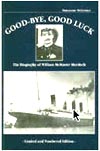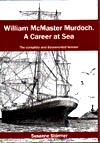|
| To Search This Site Enter Key Words Into Text Field On The Right and Hit The Search Button |
|
|
Susanne Störmer. For more information about the author and her books, check out Susanne Störmer's website.
 |
Störmer, Susanne. Goodbye, Good Luck: The Biography of William McMaster Murdoch. limited, first edition. Germany: . March, 1995. wraps. text in English. limited to 500 copies. isbn: . scarcity: very scarce.
A biography of Titanic’s first officer William Murdoch.
|
 |
Störmer, Susanne. William McMaster Murdoch, A Career at Sea. The Complete and Documented Version. 1st edition. Elmshorn, Germany: Stormbreakers. October, 2002. hardcover. text in English. isbn: 3936160007. scarcity: hard to find.
The historical biographer has a real task on their hands, attempting to bring to life a human being based solely upon that individual’s personal writings and what has been written about him by others. The challenge is that much tougher when the subject of the biography primarily lived a private, as opposed to a public life, as little to no writing about the individual by others was ever recorded. The difficulty explodes exponentially when the subject died an early death, never having the time to explain the experiences of his life in his own words.
There are almost no surviving writings from Murdoch himself, and just as little about him in the family archives. His entire life is essentially undocumented except for his one moment on center stage, his command of the bridge of the Titanic when the ship hit the iceberg. Even this moment is transitory at best, as Murdoch did not survive the disaster. History is denied his version of what happened that night. What little we do know is based on second and third hand testimony.
Such were the challenges faced by this author in attempting to bring William McMaster Murdoch to life. Considering all of these difficulties, it is astonishing how much Störmer has unearthed about Murdoch, and how well she fleshes out the facts from sterile documents to bring us her vision of who Will Murdoch was.
And make no mistake, this biography is the author’s vision of Murdoch. She takes many pieces of factual data and extrapolates them into a form that brings the man to life. How well she pulls off this feat is left up to the reader to decide. I think she has developed one version, but not necessarily the only version of who Murdoch was, and what drove the man. The strength of this book is that she gives the reader both the facts she has documented, and then her interpretation of those facts. The foundation is there for the reader to decide for themselves whether her vision is accurate or not.
This clever combination of fact and vision is the primary reason I enjoyed this book so very much, even though I happen to disagree strongly with a great many of the author’s conclusions. But more of that later. First some comments about the format of the book. It is broken down into several major sections. The introductory section dwells briefly on Murdoch’s parents and his childhood. It continues in some depth into the young man’s career in the sailing vessels, starting as an apprentice and rising in the ranks to the position of first mate. Following is a short section discussing his move into the ocean liners when he joined the White Star Line. This section discusses his start as fourth officer on the Medic through his promotion through the ranks and ships to first officer on the Olympic. The next substantial part of the book discusses his very short time on board Titanic and the tragic events that followed. Finally there is a wrap-up chapter discussing his widow’s life after Murdoch was lost in the disaster. Scattered throughout are many wonderful photographs of Murdoch during his career, and of many of the places he visited during his voyages.
But that is not yet the extent of this book. There are substantial appendices bursting with additional information. Appendix one discusses the portrayal of Murdoch in the various Titanic films. She mentions all the major movies, but the bulk of her attention is given to James Cameron’s film. As one can imagine, she has tremendous problems with Cameron’s depiction of Murdoch as an officer who would accept a bribe, shoot a man in cold blood, then commit suicide. Störmer is blistering in her attack of Cameron’s portrayal of Murdoch. This appendix also includes a short commentary with Dorothy-Grace Elder, one of the principal organizers of the Murdoch campaign that tried to set the record straight about the film. There is also a brief commentary with Ewan Stewart, the actor who played Murdoch in Cameron’s film.
Appendix two returns to a discussion of the evidence behind the real voyage of the Titanic. It is entitled merely Deductions, but that one word covers a wealth of detail including a very comprehensive discussion of ice warnings received by Titanic, a very intense discussion of her theories as to what really happened on the Last Watch (the watch in which Titanic struck the berg), and an extensive discussion of whether an officer actually committed suicide and her belief that it could not have been Murdoch.
Appendix three is a very detailed, if not virtually complete record of the voyages Murdoch made during his career and the shipmates he served with on each voyage. This appendix also includes a list of White Star Line captains according to Lloyd’s Register of Ships.
The book wraps up with some further information, acknowledgments, etc. There is a good bibliography at the end and a very extensive section of footnotes. The sum of of all this material is probably as comprehensive a view of the life of Murdoch that anyone can ever hope to amass. The amount of research that went into the writing of this book is obvious, and very impressive.
As mentioned earlier, I did have serious reservations about some of the author’s conclusions. I cannot say too much without spoiling the book for those of you who have yet to read it. Suffice it to say, that Störmer has arranged her facts in such a way that Murdoch is no longer the responsible officer in charge when Titanic has the fateful meeting with the iceberg. Her conclusions for this major revision in what are the accepted historical facts are based on what I consider to be extremely speculative evidence. Much of it based on an offhand comment fourth officer Boxhall made during the U.S. inquiry, a comment that I feel can be interpreted just as easily in other ways. When an author is going to offer up a radically different version of history than the one commonly accepted, the weight is on them to make their point beyond a reasonable doubt. She builds a circumstantial case for her version of events, but it is far from convincing.
I was also disturbed by her negative portrayal of most of Titanic's other officers, especially Captain Smith, second officer Lightoller, and fifth officer Lowe, all of whom she treats almost with contempt. Captain Smith gets especially harsh treatment, the author practically accusing him of criminal negligence in the performance of his duties. Again, I found the evidence for her conclusions about these men unconvincing. It was also surprising to me that nowhere does she even mention the very strong friendship that existed between Lightoller and Murdoch.
Despite my misgivings with her theories about how the disaster played out, and who was responsible, I feel there is more than enough new material to make this book an important contribution to the literature, especially with how it fills out Murdoch’s career at sea.
A special comment must be made about the style of the writing. The author is German, and English is a second language to her. Yet she wrote this book in English and it is a testament to her skill that unless the reader is informed otherwise, they will never realize she was not writing in her native tongue. She had the editing assistance of three English speaking friends to help her over the language bumps in the road. Their corrections are seamless and do not interfere with the author’s style, making for a very enjoyable reading experience.
Finally, one other aspect of this book must be acknowledged. Most people don’t think of a book as a physical object, but rather as the sum of its text. This book deserves special recognition for its wonderfully high printing standards. It is a hefty, solid book, that really feels the way a book should feel in the reader’s hands. It is beautifully stitched and solidly bound. There is even a cloth ribbon bookmark bound into the spine. It is the most attractive binding I have had the pleasure to handle in a very long time.
For further information and details that didn't make it into the book, see her Murdoch website.
|
|
Störmer, Susanne. William McMaster Murdoch, A Career at Sea. The Complete and Documented Version. Limited edition, SIGNED by the author and by Will Murdoch’s nephew Scott Murdoch. Elmshorn, Germany: Stormbreakers Verlag. 2004. hardcover. text in English. isbn: 3936160007. scarcity: very scarce. This version has the same cover illustration as the first edition.
|
|
|
|
|